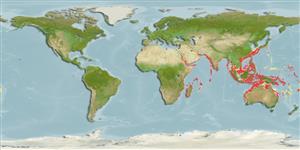Environment: milieu / climate zone / depth range / distribution range
นิเวศวิทยา
เกี่ยวกับทะเล,น้ำเค็ม สัตว์น้ำหน้าดิน; ระดับความลึก 54 - 300 m (Ref. 127946). Tropical
Indo-West Pacific: confirmed from Indonesia and Australia (Ref. 127946). Museum specimens known from the Red Sea, Somalia coast and Zanzibar. Also known from the Bay of Bengal, Arafura Sea and the Philippines (Ref. 3542). Reports from Japan are based on a different species.
ขนาด / น้ำหนัก / Age
Maturity: Lm ? range ? - ? cm
Max length : 15.4 cm SL เพศผู้/กระเทย; (Ref. 127946)
เงี่ยงครีบหลัง (รวม): 9; ก้านครีบอ่อนที่หาง (รวม): 15-16; ก้านครีบอ่อนที่ก้น: 14 - 16; สัตว์มีกระดูกสันหลัง: 32 - 33. This species is distinguished by the following characters: the lateral profile of body with slight convex curve from posterior part of first dorsal fin base to the moderately narrow caudal peduncle; with a narrow but distinct postorbital notch above and behind each eye and faint furrow across nape at rear of interorbital space; the rostral process with broad to deep medial notch and nearly straight to slightly curved anterior edge on each rostral lobe to triangular spine of moderate size at apical corner; pored lateral line scales 58-61; scales above lateral line 3 and below about 14-17; D1 IX, second distinctly longer than first, barely longer than third, and subsequent spines progressively shorter; D2 15-16 rays; A 15 (rarely 14 or 16) rays; pectoral fins reaching about fourth or fifth anal fin ray, the first free pectoral fin ray reaching to between anus and base of third anal fin ray, not or just reaching tip of pelvic fin. Colouration: a broad red band just distal to middle of caudal fin with broad ventrally tapering pink margin and transverse red band basally; inner surface of pectoral fin dark greenish brown with a large black patch covering ventral third to half of fin from base to distal margin except for fine red margin dorsally and distally and broad red margin ventrally, prominent white spots are scattered over all but red areas on fin (Ref. 127946).
A tropical to warm temperate species (Ref. 9771). Occurs over soft bottom of the continental shelf. Benthic (Ref. 75154). Excellent food fish (Ref. 3542).
Life cycle and mating behavior
วัยเจริญพันธุ์ | การสืบพันธุ์ | การวางไข่ | เซลสืบพันธ์ของเพศเมีย(ไข่) | ความดกของไข่ | ตัวอ่อน
Gomon, M.F. and T. Kawai, 2018. A review of Indonesia’s Indian Ocean species of Lepidotrigla gurnards (Teleostei: Scorpaeniformes: Triglidae) with descriptions of three new species from southern coastal waters. Raffles Bull. Zool. 66:624-651. (Ref. 127946)
IUCN Red List Status (Ref. 130435)
Threat to humans
Harmless
Human uses
การประมง: มีการค้าเพียงเล็กน้อย
ข้อมูลเพิ่มเติม
ชื่อสามัญชื่อพ้องกลไกการเผาผลาญพลังงานผู้ล่าการศึกษาเกี่ยวกับผลกระทบของสารประกอบทางเคมีที่เป็นอันตรายต่อสิ่งมีชีวิต ประชากร และสิ่งแวดล้อมการสืบพันธุ์วัยเจริญพันธุ์การวางไข่การรวมกลุ่มวางไข่ความดกของไข่เซลสืบพันธ์ของเพศเมีย(ไข่)Egg development
อ้างอิงการเพาะเลี้ยงสัตว์น้ำประวัติการเพาะเลี้ยงสัตว์น้ำสายพันธุ์พันธุศาสตร์ElectrophoresesอัตราพันธุกรรมโรคการแปรรูปNutrientsMass conversion
ผู้ร่วมมือรูปภาพหลายรูปStamps, Coins Misc.เสียงปลามีพิษ เช่น ปลาปักเป้าความเร็วรูปแบบการว่ายน้ำพื้นที่เหงือกOtolithsสมองวิสัยทัศน์
เครื่องมือ
Special reports
Download XML
แหล่งที่มาจากอินเตอร์เน็ต
Estimates based on models
Preferred temperature (Ref.
123201): 17.8 - 26.9, mean 22.4 °C (based on 499 cells).
Phylogenetic diversity index (Ref.
82804): PD
50 = 0.5000 [Uniqueness, from 0.5 = low to 2.0 = high].
Bayesian length-weight: a=0.00676 (0.00325 - 0.01404), b=3.06 (2.88 - 3.24), in cm total length, based on LWR estimates for this (Sub)family-body shape (Ref.
93245).
ระดับชั้นอาหาร (Ref.
69278): 3.5 ±0.3 se; based on size and trophs of closest relatives
ความสามารถในการกลับคืนสู่ปกติ (Ref.
120179): ความสูง, เวลาต่ำสุดที่จะทำให้ประชากรเพิ่มขึ้นเป็น 2 เท่าใช้เวลาน้อยกว่า 15 เดือน (Preliminary K or Fecundity.).
Fishing Vulnerability (Ref.
59153): Low vulnerability (10 of 100).
